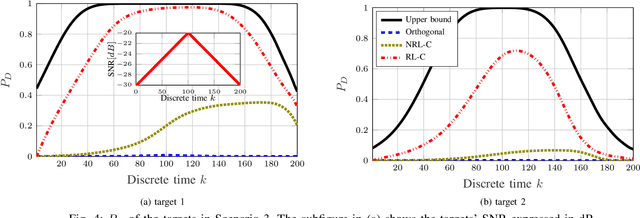Maria Sabrina Greco
Coherent FDA Radar: Transmitter and Receiver Design and Analysis
Aug 06, 2024Abstract:The combination of frequency diverse array (FDA) radar technology with the multiple input multiple output (MIMO) radar architecture and waveform diversity techniques potentially promises a high integration gain with respect to conventional phased array (PA) radars. In this paper, we propose an approach to the design of the transmitter and the receiver of a coherent FDA (C-FDA) radar, that enables it to perform the demodulation with spectral overlapping, due to the small frequency offset. To this purpose, we derive the generalized space-time-range signal model and we prove that the proposed C-FDA radar has a higher coherent array gain than a PA radar, and at the same time, it effectively resolves the secondary range-ambiguous (SRA) problem of FDA-MIMO radar, allowing for mainlobe interference suppression and range-ambiguous clutter suppression. Numerical analysis results prove the effectiveness of the proposed C-FDA radar in terms on anti-interference and anti-clutter capabilities over conventional radars.
Integrated MIMO Passive Radar Target Detection
Feb 26, 2024Abstract:Integrated passive radar (IPR) can be regarded as next generation passive radar technology, which aims to integrate communication and radar systems. Unlike conventional passive radar, which does not prioritize communication-centric radar technology, IPR technology places a higher priority on incorporating specific radar constraints to develop waveforms that are better suited for radar applications. This paper deals with the problem of distributed MIMO IPR target detection under uncalibrated surveillance/reference receivers. We focus on a communication-centric radar system consisting of several opportunity transmitters non-overlapping in frequency with the same bandwidth and several spatially separated receivers. Five new detectors are devised according to the likelihood ratio test (LRT), Rao, Wald, Gradient and Durbin criteria. Although, it is shown that these detectors are asymptotically equivalent, they provide different performance in the presence of noisy reference channels. The invariance principle is applied in this paper to show that all uncertainties affecting threshold setting can be unified in the direct-path signal power-to-noise power ratio (DNR) of the reference channels. To ensure effective detection threshold setting regardless of the DNR values in the reference channels, we introduce a novel strategy to adjust the level of the proposed detectors rather than their sizes. Then, we examine false alarm regulations and detection performance of the fixed-level proposed detectors to demonstrate their effectiveness compared to several existing detectors. Thus, we create a unified framework for uncalibrated MIMO IPR target detection in the presence of noisy reference channels.
Enhancement of a state-of-the-art RL-based detection algorithm for Massive MIMO radars
Dec 05, 2021



Abstract:In the present work, a reinforcement learning (RL) based adaptive algorithm to optimise the transmit beampattern for a colocated massive MIMO radar is presented. Under the massive MIMO regime, a robust Wald type detector, able to guarantee certain detection performances under a wide range of practical disturbance models, has been recently proposed. Furthermore, an RL/cognitive methodology has been exploited to improve the detection performance by learning and interacting with the surrounding unknown environment. Building upon previous findings, we develop here a fully adaptive and data driven scheme for the selection of the hyper-parameters involved in the RL algorithm. Such an adaptive selection makes the Wald RL based detector independent of any ad hoc, and potentially suboptimal, manual tuning of the hyper-parameters. Simulation results show the effectiveness of the proposed scheme in harsh scenarios with strong clutter and low SNR values.
 Add to Chrome
Add to Chrome Add to Firefox
Add to Firefox Add to Edge
Add to Edge